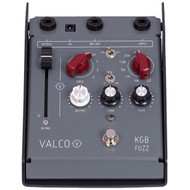KGB Fuzz - Valco
by Tom Ojendyk
Valco’s K(eyboard) G(uitar) B(ass) pedal is a large and in-charge all-in-one fuzz monster machine with four different fuzz voices as well as a wide range of tonal options controlled through the clever blend fader and Impedance selector. With four different voices, it’s easy to find a sound that pairs well with any type of amplifier, keyboard, guitar, or bass, whether you are using single coils, humbuckers, or P90s. The sturdy enclosure ensures it can withstand the most rigorous usage and while it’s bigger than your standard pedalboard-friendly pedal, its ability to cover so much ground means it could be the only fuzz pedal you might need in your chain.
The pedal’s main controls are Output, Tone, and Fuzz and each covers a lot of ground. Vintage fuzzes often don’t have a lot of output, but the KGB has more than enough volume on tap. If you don’t need a huge fuzz sound, you can just increase the output, lower the fuzz, and get a classic 70s overdrive sound. The Tone and Fuzz controls also have a big sweep, which is great since you will want to set it based on the Voice knob. It uses a silicon diode and NPN transistor for clipping so the pedal won’t be finicky like one using germanium diodes, and you’ll have a more consistent and reliable sound regardless of the temperature.
The 4-position Voice knob covers a slew of classic fuzz tones that you can further adjust using the Impedance selector. In the “off” Voice position, the pedal bypasses the tone knob and the fuzz sounds similar to a Fuzz Face. Compared to a current silicon Dunlop Fuzz Face, the KGB sounds slightly less woofy and you can adjust the EQ with the Impedance selector to ensure that you stand out more in the mix. The “off” Voice is also the only position that doesn’t use the tone knob so if you select any of the other three Voices, you will have control over the EQ.
The first Voice position will give you a giant and mid-scooped classic Big Muff sound and when compared to a current Electro-Harmonix Big Muff, the KGB sounds nearly identical but with more output. The second Voice position is a more mid-forward Tone Bender-style sound and perfect for folks looking for a 60’s vintage-style fuzz. There are a bunch of different types of Tone Benders out there and the KGB sounds more like a later 60’s version with the Tone Control, which is a lot easier to control than the earlier 2 knob versions. The third Voice is a gated fuzz that has the same EQ as the second Tone Bender voice, but with an added gain stage, and it will sputter out when you max the fuzz setting. Lowering the fuzz will get you a Velcro-y fuzz tone that sounds chaotic but still musical.
The Impedance selector is a really cool feature that changes the tonality. There are six settings that start at 10k and max out at 1M, and generally, the lower the setting the less saturation. Vintage fuzzes used a lower impedance, which is why they can be fussy based on what kind of pickups you are using, so being able to control or increase the impedance makes this pedal get along with any guitar regardless of its pickups. It’s simply activated by setting the “Line/Instrument” switch to “Ins,” and when you increase the impedance it will affect the EQ and compression level. The selector gives you a lot of tonal options and it’s incredibly easy to find the selection that works best with the fuzz voice and your set up.
The Blend slider controls the mix from the dry and fuzz signal so putting it at zero will give you a completely clean sound even though it’s still routed through the Impedance selector. This feature is especially handy for bass players who can set it at the best position to maintain low end. Adjusting the blend is also helpful to maintain your attack if you are maxing out the fuzz level. There is also a Phase switch that reverses the Dry audio signal when used with the Blend slider.
KGB is all-analog and can be powered either by a 9-volt battery or a standard AC power supply. Parts of the layout are a little quirky with the input, output, and dry out jacks on the top of the pedal, which can make wiring it with other pedals a bit tricky. Like a lot of fuzz, the KGB also likes to be first in the chain. Despite the ability to have heavy gain, the noise level is quite low, even with single coil pickups. When I used this with the synth I had on hand (Sequential Pro 3), this wasn’t an issue and the KGB shined pretty well. It’s flexible enough to add subtlety, something I find is necessary with fuzz + synths, as I’m usually using this combination to add a little extra teeth, not end-of-the-world destruction.
Overall, this is a great sounding fuzz that has a lot of tonal options but is also easy to dial in that it works for all three instruments it’s named after. For guitar, I tested the pedal using a Telecaster, an SG with P90s, and a Les Paul going through a 70s Fender Vibro Champ with an 8” speaker, a Fender Super Reverb with 4x10” speakers, a 60’s Fender Bassman running through a 4x12,” as well as a mid-60s Ampeg Gemini with a 15” speaker and it performed splendidly in all of them. You can set the fuzz low for classic distortion tones or crank everything to get a ferocious wall of fuzz sound, and the ample tone options ensure that you won’t get lost in the mix like a lot of other fuzzes.
Price: $299
valcofx.com


